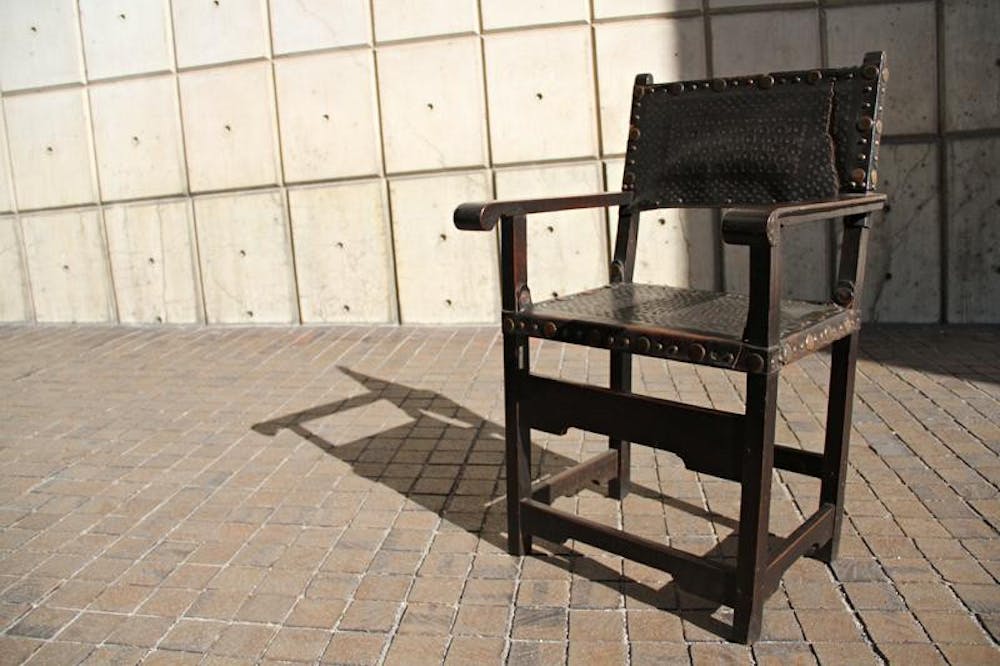As President Christina Paxson steps onto the inaugural stage Saturday donning the presidential gown and chain, she will play the lead role in a University tradition that stretches back nearly 250 years.
The University will host a community event celebrating Paxson tonight at the Veterans Memorial Auditorium, with actress Kate Burton '79 serving as the master of ceremonies. The formal inaugural ceremony will occur Saturday afternoon on the Main Green and will include a faculty procession, the president's inaugural address and a reception.
"We've been much more proactive than in past inaugurations in terms of inviting the public," said Russell Carey '91, executive vice president for planning and policy, adding that the University advertised the events in publications such as the East Side Monthly to reach out to the larger Rhode Island community.
"Every inauguration is a moment for celebration - an opportunity to engage faculty, students and members of the community," said Marisa Quinn, vice president of public affairs and University relations. "We sought to have a forward-looking, optimistic, celebratory, welcoming theme."
Though Paxson was sworn in her first day of office in July, the Saturday ceremony will introduce her to the community and incorporate several inauguration traditions, such as the presentation of a tin box containing a photocopy of the Brown charter.
"It's an opportunity to ... participate in something that doesn't happen that often," Carey said. "It's an almost 250-year-old institution, and this is only the 19th person to be in that office."
Inauguration through the ages
The University's inauguration celebrations developed "from a simple rite to an elegant celebration," according to Encyclopedia Brunoniana, a book detailing University history. No formal ceremony was held for the first four presidents, and subsequent presidents were inducted into their positions at a ceremony in a Baptist Church.
But the inauguration became a more elaborate affair with the appointment of William Faunce in 1899, when Harvard, Princeton and the University of Chicago presidents traveled to Brown to give speeches to commemorate the occasion.
In 1929, classes were canceled the Friday of Clarence Barbour's inauguration weekend so that students and professors could attend festivities.
But these events were not universally popular. "The purpose of an inaugural ceremony is to give the heads of academic and scholarly institutions an opportunity to assemble and give each other reassurance that they are important. The colorful robes, the stately music, the assemblage of dignitaries, are all carefully planned to impress," wrote Jean Braucher '72 P'14 in a column in The Herald in 1970. "But the fact that no more than 200 students bothered to attend the inauguration of Donald F. Hornig shows that all the pomp doesn't appeal to them."
In 1977, the University faced budgetary problems, and incoming president Howard Swearer opted for a low-key inauguration. Still, Russian cellist Mstislav Rostropovich performed at the event and celebrations continued over three days.
The biggest and most star-studded inauguration to date was that of Vartan Gregorian in 1989, said Jane Lancaster MA'93 PhD'98, University historian. The event featured an address by Pulitzer Prize-winning historian Arthur Schlesinger and a performance of Vivaldi's "Four Seasons" by violinist Pinchas Zukerman. Huge parties were held to incorporate people from the New York Public Library, Gregorian's former employer, into "Brown's fundraising orbit," Lancaster said.
Gregorian also made efforts to reach out the Rhode Island community, inviting the presidents of each of the state's colleges and universities to sit in the front row.
"He made sure those guys all looked good and had a great place to sit, and he went out of his way to say, 'I want to particularly express my thanks to my fellow presidents for showing up,'" said Robert Emlen, University curator. "And I thought Vartan - he's hot. He's going to be great at this job."
Brown's last inauguration took place in 2001 with the induction of Ruth Simmons. The weekend festivities included faculty panels and an inaugural concert with performances by revered artists including author Toni Morrison. The celebration coincided with Brown's homecoming football game against Princeton that year.
Tonight's inaugural celebration event will feature student groups - the Brown University Jazz Band, Word!, Ghanian Drumming and Dance Ensemble, Badmaash Dance Company and Brown University/Trinity Repertory Company MFA students - as well as the What Cheer? Brigade and Providence poet Christopher Johnson.
Providence Mayor Angel Taveras, Gov. Lincoln Chafee '75 P'14, U.S. Sen. Jack Reed, D-R.I., and Princeton President Shirley Tilghman will be speaking at the ceremony. Representatives from other universities, including the presidents of Rhode Island colleges and universities will be in attendance. Former Brown presidents have also been invited.
Ceremony symbols
In 1966, Ray Heffner became the first president to wear the presidential chain, which consists of 10 scallop shells that signify goodness and wisdom, according to the University's inauguration website.
Heffner also wore the presidential gown, designed by the wife of Corporation fellow John Nicholas Brown in 1964 to have adjustable helms so it could be customized for each president, according to Encyclopedia Brunonia.
These traditions carry into today's ceremonies. Along with the chain an
d gown, the chancellor will present the president with a mace, tin box and the Manning Chair.
The tin box, approximately 9 by 11 inches, has been in the University's possession since the 1800s and originally held a ceremonial copy of the University's charter printed on vellum, Lancaster said. In 1937, at the inauguration of Henry Wriston, the box and charter appeared to have been misplaced.
Ben Brown, the marshal of ceremony that year, "leapt off the platform as the last bars of the processional march were sounding to look for the document," The Herald reported April 6, 1989. Luckily, "an usher found it at the last instant under the arm of an alumnus sleeping in the back of the hall."
Though it was initially stored in University Hall, at some point in the 20th century it was moved to a vault downtown at the Rhode Island Hospital Trust National Bank for greater security, Lancaster said.
In 1938, a hurricane struck Providence, and the box and the charter inside were both submerged in water.
"They opened the tin, and there was nothing," Lancaster said. "The vellum was still there, but the vegetable ink had washed off." The vellum also no longer fit in the tin, as it had expanded due to its contact with water. Only the residue of the wax seal - the Rhode Island state motto "hope" - remained.
Today, the box contains a photocopy of the charter taken before the hurricane. Former Chancellor Stephen Robert '62 P'91 alluded to this little-known fact at Simmons' inauguration when he said to her, "you know there's nothing in there" - not realizing his microphone was still on, Lancaster said.
Despite its damaged state, the charter's symbolic passing remains a key element of the ceremony.
The president will be seated on the Manning Chair for the inauguration ceremony Saturday. Made in Spain more than 300 years ago, the chair was donated to the University by its first chancellor, Stephen Hopkins, in the 1780s, when James Manning was president, Emlen said.
"The old schools all have a chair," he said. "By sitting in this chair, the president assumes both literally and figuratively the authority to lead the University."
Paxson will also be handed a historical mace or war club created by the Gorham Silver Company in the 1920s.
"It's a great big heavy thing you have to carry with two hands," Emlen said, adding that the names of the former Brown presidents are inscribed on the mace.
There seems to be a theme of "invented traditions" that have been incorporated into the ceremony over time, Lancaster said. But she added that they help trace back an institution's history.
"This is just a public version of the private swearing in ... (but) if you ignore these markers of the passing of time, life's a bit dull," she said.





